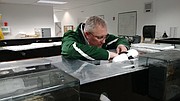St. Regis students learn how to hatch and raise trout
In a spacious, well-equipped lab Brooks Sanford and his students at St. Regis High School are watching nature in action while helping hatch and raise juvenile rainbow trout.
In the process they learn about wildlife habitat, environmental conditions and the life cycle itself as they watch and take part in the development of the fish, Arlee Rainbow Trout, from fertilized eggs to three-inch long yearlings that will be released this coming spring.
Starting with 252 eggs donated by the Jocko River Hatchery near the town of Arlee on the Confederated Salish, Kootenai Tribe reservation, students have received first-hand knowledge of the conditions necessary to produce the trout.
“The students study the life cycle of the trout, including keeping growth rate charts, mortality rates and other data,” said Sanford, a former wildlife biologist for the Idaho Department of Fish and Game. “The can see how the water has to
be circulated within a narrow temperature range and what is involved in the feeding process.”
The newly hatched trout have been kept in a “pen” inside the large aquarium for four days with water temperatures kept within at a consistent range below 60 degress.
This week the newborns were freed from the pen after gravel had been added to the bottom. The fish, who still have yolk sacks attached for their initial nutrition needs, have not developed mouths at this early stage that would allow
them to eat foods in the water. They seek shelter in the gravel bottom until nature develops their ability to feed on their own.
“This is a lot of fun for the students as well,” Sanford said. “Once they have used up the yolk sacks and have developed the ability to feed on their own, the focus becomes how much and what kind of food they will need to survive.”
Students also learn about chemistry that keeps the fish alive, Sanford said, such as making sure nitrate levels are within the proper range.
“The lessons also include emphasis on fish management and aqua-culture,” he added. “For me, it’s fun to teach something you know a lot about.”
Students also go on a tour of the Jocko River hatchery as part of the class curriculum.
Now in it’s second year of the trout raising program, Sanford said he is hoping to expand next year to include smallmouth bass rearing, which would greatly expand the learning potential due to the different conditions and type of fish involved.
“The bass are voracious predators,” he said. “Raising them would require different water temp and feeding conditions.”
This spring, the trout will be released into a children’s fishing pond at the town’s Community Park. At that time they will be three to four inches long. Arlee Rainbow Trout are not a native species and cannot be released into open waters in Montana.
Jake Lohman, a junior at the school, said he really likes the program and the many things he has learned.
“I really like being part of this,” Lohman said. “It’s fun and we learned a lot about the fish, ph levels in the water and what improper acid balance can do. This (wildlife biology) is something I may want to do in life.”
Last year the class matched the average mortality rate of young trout by successfully raising 4 percent to the release point.





